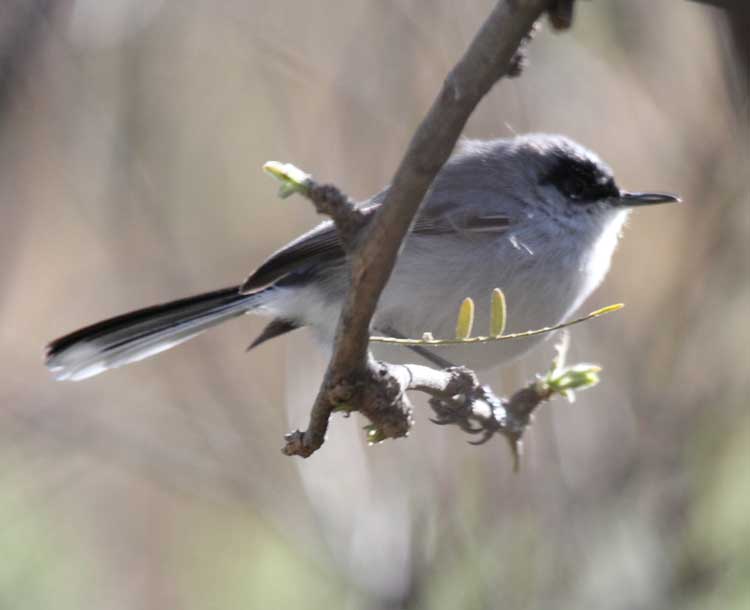
Polioptila nigriceps (*)
Superregnum: Eukaryota
Cladus: Unikonta
Cladus: Opisthokonta
Cladus: Holozoa
Regnum: Animalia
Subregnum: Eumetazoa
Cladus: Bilateria
Cladus: Nephrozoa
Superphylum: Deuterostomia
Phylum: Chordata
Subphylum: Vertebrata
Infraphylum: Gnathostomata
Megaclassis: Osteichthyes
Cladus: Sarcopterygii
Cladus: Rhipidistia
Cladus: Tetrapodomorpha
Cladus: Eotetrapodiformes
Cladus: Elpistostegalia
Superclassis: Tetrapoda
Cladus: Reptiliomorpha
Cladus: Amniota
Classis: Reptilia
Cladus: Eureptilia
Cladus: Romeriida
Subclassis: Diapsida
Cladus: Sauria
Infraclassis: Archosauromorpha
Cladus: Crurotarsi
Divisio: Archosauria
Cladus: Avemetatarsalia
Cladus: Ornithodira
Subtaxon: Dinosauromorpha
Cladus: Dinosauriformes
Cladus: Dracohors
Cladus: Dinosauria
Ordo: Saurischia
Cladus: Eusaurischia
Subordo: Theropoda
Cladus: Neotheropoda
Cladus: Averostra
Cladus: Tetanurae
Cladus: Avetheropoda
Cladus: Coelurosauria
Cladus: Tyrannoraptora
Cladus: Maniraptoromorpha
Cladus: Maniraptoriformes
Cladus: Maniraptora
Cladus: Pennaraptora
Cladus: Paraves
Cladus: Eumaniraptora
Cladus: Avialae
Infraclassis: Aves
Cladus: Euavialae
Cladus: Avebrevicauda
Cladus: Pygostylia
Cladus: Ornithothoraces
Cladus: Ornithuromorpha
Cladus: Carinatae
Parvclassis: Neornithes
Cohors: Neognathae
Cladus: Neoaves
Cladus: Telluraves
Cladus: Australaves
Ordo: Passeriformes
Subordo: Passeri
Infraordo: Passerida
Superfamilia: Certhioidea
Familia: Polioptilidae
Genus: Polioptila
Species: Polioptila nigriceps
Subspecies: P. n. nigriceps – P. n. restricta
Name
Polioptila nigriceps S.F. Baird, 1864
Type locality: Mazatlan, Sinaloa, Mexico.
References
Baird, S.F. 1865. Review of American Birds in the Museum of the Smithsonian Institution. Part 1. North and Middle America. Smithsonian miscellaneous collections 181: vi–478 pp. BHL Reference page. Original description p. 69 BHL
Vernacular names
English: Black-capped Gnatcatcher
español: Pelita capirotada
The black-capped gnatcatcher (Polioptila nigriceps) is a small songbird in the family Polioptilidae. It is found in Mexico and the United States.[2]
Taxonomy and systematics
The black-capped gnatcatcher has at times been treated as conspecific with the white-lored gnatcatcher (Polioptila albiloris). Two subspecies are recognized, the nominate Polioptila nigriceps nigriceps and P. n. restricta.[3][2]
Description
The black-capped gnatcatcher is 10 to 12 cm (3.9 to 4.7 in) long and weighs 5 to 8 g (0.18 to 0.28 oz). Adults are blue-gray on the upperparts with white underparts. They have a long slender bill and a long black tail with mostly white outer feathers. Males in alternate (breeding) plumage have a glossy black cap. The female's gray upperparts have less of a bluish tint but are otherwise similar to the non-breeding male. This species is very similar to the black-tailed gnatcatcher (P. melanura).[3]
Distribution and habitat
The nominate black-capped gnatcatcher is found in western Mexico from central Sinaloa south to Colima. P. n. restricta is found mostly in western Mexico from eastern Sonora south to northern Sinaloa. It has occasionally nested just across the U.S. border in the Madrean sky islands area of southernmost Arizona. In the northern part of its range it inhabits mesquite thickets near riparian corridors. To the south it inhabits thorn scrub and arid deciduous woodlands. In elevation it occurs mostly below 500 m (1,600 ft). The species is primarily non-migratory, though the northernmost birds might move south after breeding.[3]
Behavior
Feeding
The black-capped gnatcatcher's diet has not been documented. It is assumed to be arthropods like the diets of other gnatcatchers. They forage actively in trees or shrubs, gleaning foliage and sometimes sallying to catch insects.[3]
Breeding
The black-capped gnatcatcher's breeding season spans from March to June, with the last fledging in July. The nest is a small cup constructed of twigs cemented with spider silk, lined with softer material, and placed on small branches of a low tree or shrub. The clutch size is four. Parasitism by brown-headed cowbirds (Molothrus ater) has been observered in Jalisco.[3]
Vocalization
The black-capped gnatcatcher's song is complex and rambling [1]. It also has a "mewing" call that is sometimes repeated [2].[3]
Status
The IUCN has assessed the black-capped gnatcatcher as being of Least Concern.[1] However, "Both races [are] restricted to ecoregions considered to be at serious risk due to agriculture and cattle grazing."[3]
References
BirdLife International (2018). "Black-capped Gnatcatcher Polioptila nigriceps". IUCN Red List of Threatened Species. 2018. Retrieved 29 May 2021.
Gill, F.; Donsker, D.; Rasmussen, P. (January 2021). "IOC World Bird List (v 11.1)". Retrieved 14 January 2021.
Atwood, J. L. and S. B. Lerman (2020). Black-capped Gnatcatcher (Polioptila nigriceps), version 1.0. In Birds of the World (J. del Hoyo, A. Elliott, J. Sargatal, D. A. Christie, and E. de Juana, Editors). Cornell Lab of Ornithology, Ithaca, NY, USA. https://doi.org/10.2173/bow.bkcgna.01 retrieved 29 May 2021
Retrieved from "http://en.wikipedia.org/"
All text is available under the terms of the GNU Free Documentation License

